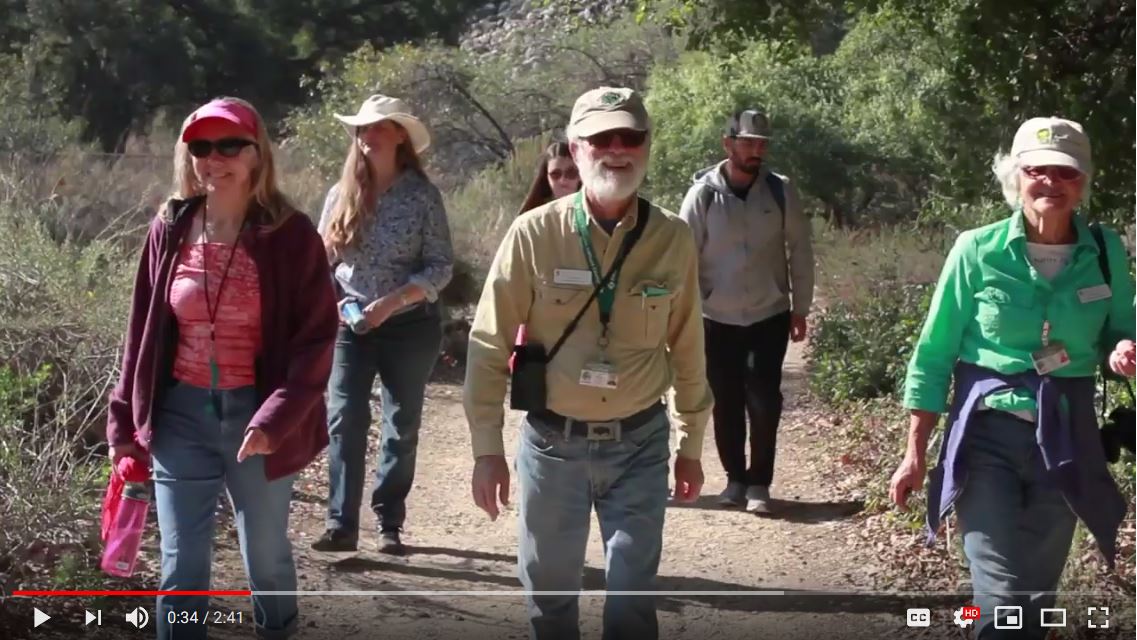Sharing the Mountains: The challenge of increasing access to nature while balancing the many uses of the San Gabriel Mountains
A multi-media production by Erika Klein
Available online at https://uscstoryspace.com/2017-2018/erikajkl/Capstone/CapstoneEK/.
(portions reprinted with permission from the author)

|
On an August evening nearly 30 years ago, Cliff McLean invited his girlfriend to go on a hike in the San Gabriel Mountains. "She said she was tired, she didn't want to go," he recalls. "I said, 'Let's just go, you'll feel better if you get out.'" On an August evening nearly 30 years ago, Cliff McLean invited his girlfriend to go on a hike in the San Gabriel Mountains. "She said she was tired, she didn't want to go," he recalls. "I said, 'Let's just go, you'll feel better if you get out.'" On the trail where they had often hiked, he proposed. Gabi McLean couldn't see the ring in the darkness, but she said yes anyway. The San Gabriels are not only where the McLeans got engaged, but also where they met. Interested in getting into hiking after moving to L.A. as an adult, Gabi says the mountains initially looked brown and uninviting. She found out about a docent-guided walk that met Sunday mornings and began attending every week. "Whereas before everything was kind of sad-looking to me and dry, I discovered there was really life and have been liking the mountains ever since," she says. Cliff separately began joining the walks. He met Gabi for the first time in the parking lot of the Eaton Canyon Nature Center and, a quarter-century of marriage later, the two sometimes lead the walks themselves as active members of the California Native Plant Society, San Gabriel Mountains Chapter. Now retired, they devote at least half of their time to environmental issues. Dedicated to the mountains they both love, they volunteer with the society and at the Nature Center to help preserve the area and to spread their appreciation of the outdoors to others in the Los Angeles community. |
They have noticed more visitors to the mountains, with hundreds of people nearly clogging the trails in the Eaton Canyon Natural Area at the base of the mountains. These visitors—women jogging with their dogs, teenagers roaming with their friends, even families pushing strollers—can make the wide dirt trails almost resemble city sidewalks. But besides instilling trail etiquette and care for natural resources in these visitors, the people already visiting the mountains are not the ones the McLeans are primarily hoping to reach. "The people that come here, they're already interested in nature. That's why they come here," Gabi says. "But that's one of the things we're discussing—how do we reach the people to whom nature isn't anything important." The mountains, a backdrop to Los Angeles located within 90 minutes of over 15 million people, play host to multiple uses and a seemingly increasing number of visitors. The area has been in the news in recent years with the establishment of the San Gabriel Mountains National Monument by former President Barack Obama in 2014. When President Donald Trump later called for a review of the country's national monuments, the new monument—though ultimately unaffected—again came to the public's attention as a valuable natural area. The mountains supply 70 percent of L.A. residents' open space, as well as 30 percent of their drinking water. The area also hosts native animals and plants, historic structures and sites, and business and recreational activities, among other uses. [The article continues with interviews of other people, including our friend Dr.Naomi Fraga, Director of Conservation Programs for the Rancho Santa Ana Botanic Garden, and then resumes with us.] |
Keeping California plants native
|
For Gabi and Cliff McLean, who is currently president of the local California Native Plant Society chapter, invasive plants are a significant issue. California has over 1,500 non-native plant species, around 215 of which can cause harm to the environment. More than half of these plants were brought to the state deliberately as ornamental plants, food, or for other purposes, and they can continue to spread to the mountains from urban gardens. Invasive plants can threaten the biodiversity of natural habitats and lead to increased risk of fire and erosion. The CNPS San Gabriel Mountains Chapter activities include a focus on conservation and native plant gardening, as well as on removing invasive plants. Gabi says they have taken part in some weed removal projects, but that they have encountered issues in the past working with the Forest Service due to bureaucratic restrictions. It can also be difficult, she says, to train volunteers so that they don't uproot the wrong plants. |
Forest Service botanist Katie VinZant worked in the Angeles National Forest in the San Gabriels for nearly 10 years before recently transferring to Arizona. "I think there's a lot of things that everyone at the Forest Service wishes they could do, but it's very stipulated by funding, by the amount of personnel, by time," she says. She says that the Forest Service employed four botanists in the area in 2010; now, it's down to one. "It's not just, 'Oh I don't want to work with CNPS,' it's definitely not the case," she says. "It's just I can never find time." Despite their challenges working directly together, both organizations pursue many similar goals related to conserving the native landscape. |
[The article continues with more interviews and videos of other people, and then concludes.]
|
The issue of spreading awareness of the forest—while preserving its isolated, wilderness feel—is a focus of many who spend time in the mountains. "I think for many people [the mountains] are just a background that's there that doesn't appear very interesting to them," says Cliff McLean. "In the summer and fall they're just brown, and they don't think of them at all." |
He and Gabi say they want to encourage people to visit the mountains to increase their appreciation of the environment, but doing so may compromise the experience of those already there. "That's why we're torn," he says. "We think that more people should know about them and appreciate the San Gabriel Mountains, but the more people we get into the mountains, the more congested it is and the less enjoyable it is to get out there." |
Keywords: Gabi McLean, Cliff McLean, Gabriele McLean, Clifford McLean, Nature at Hand, Gabi Horn, Gabriele Horn, Plants of the San Gabriel Mountains: Foothills and Canyons, Plants of the San Gabriels, California native plants, Pasadena, Los Angeles, Los Angeles County, San Gabriel Valley, Southern California, Altadena, Covina, natural, nature photography, photograph, environmental education, naturalist, docent, hike, hiking, CD-ROM, California native garden, gardening, flowers, wildflowers, San Gabriel Mountains, Angeles National Forest, California Native Plant Society, CNPS, Eaton Canyon Nature Center Associates, ECNCA, iPhone, iPad, iPod Touch, SGMPlants
